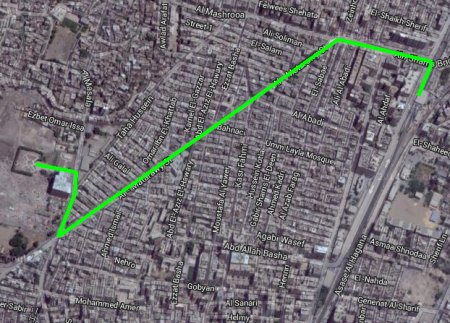
|
| |
 |
Heliopolis Obelisk
| Present Site: | Matareyya, Heliopolis, Egypt N 30°07'45.8"(30.129396) E 31°18'27.0"(31.307496) |
| 1. | Pharaoh: | Senusret I (Middle Kingdom the 12th Dynasty, Reigned 20 Century BC) | Measurement: | 20.4 meters high for obelisk itself |
| Stone: | Red granite | |
| 2. | Pharaoh: | King Teti (Old Kingdom the 6th Dynasty, Reigned 24 Century BC) |
| Measurement: | About 1 meter high for obelisk itself (Only the upper portion) | |
| Stone: | Quartzite |
About The Site:
These two obelisks are in Heliopolis, suburb of Cairo in Egypt. Heliopolis is an ancient city which was flourished since the Old Kingdom Era, and the center for the Solar Deity. However after Ptolemaic Dynasty, the religious object shifted from Ancient Egyptian God and Goddess to Greek God and Goddess, Heliopolis was devastated, and came to ruin in the Ancient Roman Era. As a result, many obnelisks were carried away from Heliopolis.
Eight obelisks were carried out to outside Egypt.
This is a proof how Heliopolis was a great temple complex in the past.
At present, only this obelisk stands in Heliopolis, and no ruins remain. Probably due to the closer location to Cairo, the area was developed for many years, and the stone materials would probably be reused for others.
The place where the obelisk stands is about 70 m square, this was once made for the park-like area for accepting many visitors, but this is not publicly opened now, and the place like an open-air exhibition facility remains. in which keeps some antiquities which were found from the underground of Heliopolis.
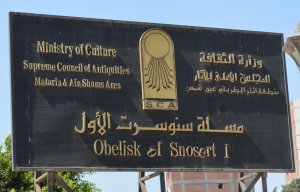 Signboard for the Obelisk Site (2014)
Signboard for the Obelisk Site (2014)That has been removed when I visited in 2016. |
The place where the obelisk stands is Matareyya district, a part of north-east suburb of Cairo. When I visited here in August 2014, on the way from the Metro station Ain Shams, I was called by a taxi driver who speaks English well. So I asked him to bring me to the obelisk site. When we entered into the site, the two security personnels suddenly appeared to us, and banned entering the site. They shut out the gate, and said "Take pictures of obelisk over the fence outside the site" against my request "I wish to take pictures with the angles of each side". But due to the trees, the obelisk cannot be taken from the back side angle, and a lot of garbages such as construction waste, electric appliances and broken cars were scattered around there. Entering the waste dump site, the circumstances changed, and the taxi driver who accompanied me scared and said "Take pictures quickly and leave from here soon" "We may be killed if we stay longer in such a place". So I gave up taking pictuires at that time.
When I visited here again in April 2016, I brought a selfie stick which can be extended to 5 meters in order to take pictures through the fence, and together with the Tourist Police due to the poor security. Unfortunately I failed to take clear pictures for north-side and west-side of the obelisk due to a bad hour. So, I re-visied here in May 2017.
After visiting, looking the satelite image of Google Maps, I thought the vast waste dump site would be the remains of excavated site of Heliopolis. So the site was avoided from the development because it's probably a government-owned site due to the ruins. But due to the poor management, the site became the waste dump. It's natural the environment becomes bad, walking around here is high risk.
How To Get There:
From the Metro station Sadat or Nasser, take Line 1 bound for New El-Marg, and get off at Ain Shams station. Go to the direction of Ain Shams Bridge (overpass) in North. (See map with the green Line) Then, turn left at the overpass, and turn left again about 200 m ahead at the broad street named Al-Matarawy Street. About 600 m ahead, there is a outlet shopping mall named Teba Mall at right hand side, another 200 m ahead another street crosses like letter "V", turn right here, and after proceeding 150 m, here is a large building. Then we can see the obelisk at left side. This route is a little detour, but it would be safer if we walk such a broad street in daytime. But we may feel shattered atmosphere around the obelisk site. The middle class apartments with pretty landscape and the slum area with abandoned broken cars are adjacent. Please do not enter if the surrounding atmosphere changes.
About The Obelisk:
1. Senusret I Obelisk
This obelisk in Heliopolis ia the oldest obelisk among all the standing obalisks worldwide. This 20.7 m high obelisk was erected by Senusret I (Middle Kingdom the 12th Dynasty, Reigned 20 Century BC). Although this has been standing almost 4000 years in this place, but due to the rise of groundwater level the pedestal and the bottom of obelisk became immersed in water, the construction of raising the obelisk was done in the 1970s by Krupp of Germany.
One another obelisk by Senusret I exists in Faiyum.
With regard to the inscriptions of this obelisk, they are same for all 4 sides. By taking pictures in 2014 and 2016, that was confirmed. Labib Habachi says so in his book "The Obelisk of Egypt" (1984).
The horus name, coronation name, birth name of Senusret I are inscribed. I think the writing rule of this obelisk would be the standard for the obelisks later times. However, the horus of this obelisk has no Pschent (double crown), although the horus of most obelisks in the New Kingdom has Pschent which symbolizes the unified dynasty of upper and lower Egypt.
In anyway, it's surprising that the obelisk inscriptions remain like this beautifully for nearly 4000 years. I was very impressed that the Hieroglyph's typeface is neat and beautiful. Also, the fact that standing here without collapsing for 4000 years is also surprising.
The height of this obelisk is 20.4 meters (*1, *2), and the weight is about 121 tons (*2).
(*1) The Complete Temples of Ancient Egypt, Richard H. Wilkinson.
(*2) The Obelisks of Egypt, Labib Habachi.
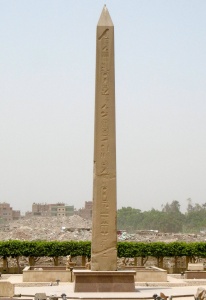
East Side April 26, 2016 |
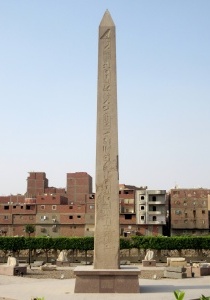 South Side May 3, 2017 |
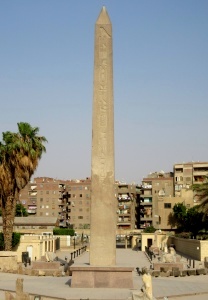
West Side May 3, 2017 |
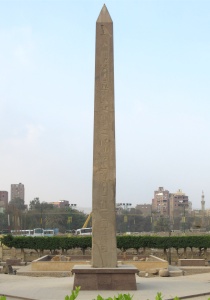 North Side May 3, 2017 |
|||
by Hiroyuki Nagase (For high definition image, please click the picture) | ||||||
 Inscription
Inscription
|
2. King Teti Obelisk
Beside of Senusret I Obelisk (mentioned above), the fragment (top portion) of King Teti Obelisk is placed in the open-air museum. King Teti is the first Pharaoh of 6th Dynasty in the Old Kingdom Era (reigned: 2345-2333 B.C.). This is the oldest obelisk in the world as the king name is engraved.
This was discovered in Heliopolis in 1970s. This is a top portion where the Horus Name is engraved. The inscription is recorded in the book "The Obelisks of Egypt" (by Labib Habachi). The process of the discovery is recorded in the website "Excavation in Ain Shams" by Dr. Zahi Hawass, an Egyptian archaeologist and the Secretary General of the Supreme Council of Antiquities. He says in this site, "we have built an open-air museum in this area (park) that Senusret I Obelisk stands." Also, on the another website, a picture is publicized, which is likely to be the part of this obelisk. In addition, on the website of flickr.com, another fine picture is posted with the level that the hieroglyphs almost can be read.
In August 2014, I failed to confirm this obelisk (part) because I couldn't get into the site. During the second visit in April 2016, I took pictures of Senusret I Obelisk with a selfie stick which can be extended to 5 meters. When taking pictures, I realised that an obelisk-like stone block in the south side of the Senusret I Obelisk site. Then, I focused it by the telescope lens from the north side. However, the sharpness of my picture was not very good, only the surrounding frame of inscription is barely able to understand. The inscription is engraved only on the one side, and the back side is considerably damaged.
In 2017, I re-visited here again in early morning, as the picture can be taken with a high contracst avoiding a backlight. Taking a picture with a telescopic lens from about 40 m away, I was able to take a picture of the level that the name of the king can be confirmed. The right figure is a re-created inscription beased on my picture and the drawing which was in the book "The Obelisks of Egypt" (by Labib Habachi).
Since the coronation name in the inscription is interrupted, we understand only the upper portion remains, and the lower part is missing. According to the book "The Obelisks of Egypt" (by Labib Habachi), it's estimated about 3 meters high in total.
According to the established theory, only a small obelisk was erected at the entrance of tomb in the Old Kingdom Era, and the obelisk for the temple was commence after the Middle Kingdom Era. However, by discovering of this King Teti Obelisk (Old Kingdom) in the Sun God Temple in Heliopolis, such theory was denied. The origin of obelisk dates straightly back to 400 years, becoming the 6th Dynasty in the Old Kingdom Era. In that sense, this King Teti Obelisk is a very precious existence.
Just for the reference, The Czech Institute of Egyptology excavated the large "obelisk" in the ruins of Abusir, south of Giza, after 1970s. However, this has a thick and tubby shape, and this is definitely different from the obelisk which was erected as a pair in front of the temple after Senusret I, in terms of its shape and objectives.
by Hiroyuki Nagase (For high definition image, please click the picture) | ||||||
Notes For Pictures:
At the ancient ruins in Egypt, the regulation is getting stricter and many places are prohibited to access by the rope. For examples, the surrounding area of Pyramids in Giza, right side hill looking down toward the Mortuary Temple of Queen Hatsheptsut, and the south side of Seti II Obelisk in Karnak. The places where we can walk freely in around 2008 became not to be allowed to enter at present.
Since Matareyya District is a place where public security is bad, I think the park (obelisk site and the open-air museum) will be closed for the time being. Therefore, I was thinking how to successfully take pictures over the surrounding trees. Firstly, I came up with using a "drone" (unmanned small aerial vehicle). However, I abandoned this idea because using drone is strictly prohibited in Ezypt. Then, I found a "selfie stick" (called "Kame-Boh" in Japanese) which can be extended to 5 meters. I could take pictures of Obelisk with a selfie stic, over the trees in April 2016. However, I couldn't not take fine pictures of the north and west sides because the timing was bad and the backlit. Also this time, cow's carcasses were thrown away in the garbage dumping ground and they had an intense death smell under the scorching sunlight. The accompanying guide and the Tourist Police were holding their noses with handkerchiefs, and taking pictures in such environment was very hard.
Copyright Hiroyuki Nagase nagase@obelisks.org and Shoji Okamoto okamoto@obelisks.org